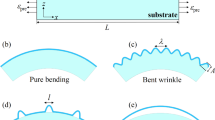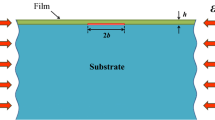Abstract
Film/substrate systems with periodic surface morphology generated by elastic instability can have important applications in elastic wave control, as proved by previous finite element analysis. However, experimental verification remains a challenge because of the limited magnitude and adjustment of patterns wavelength, the interface debonding and the structure warpage. A novel experimental method in which film and substrate are selected homologues, and two-phase moisture curing process is adopted to control the physical state of the substrate, the surface pattern and the residual mismatch stress was firstly proposed to prepare the bilayer structures without the detachment and the warpage. Vibration test showed that propagation of the elastic waves could be suppressed in the fabricated bilayer system. Through modelling the formation of surface patterns and the propagation of elastic waves, finite element simulation and dimensional analysis were carried out to examine the band-gap performance of various bilayer structures. Numerical results show that the wavelength of surface patterns which depends on four processing parameters, i.e., the instability load, the film thickness and the elastic moduli of the film and the substrate after the first curing, is crucial to the band-gap properties of film/substrate systems. An analytical expression is given to approximately estimate the surface patterns wavelength and a design guide is suggested to manufacture the film/substrate system considering the film limiting conditions in practice.








Similar content being viewed by others
Data Availability Statement
This manuscript has associated data in a data repository. [Authors’comment: Data will be made available on reasonable request.]
References
S. Chen, Y. Fan, Q. Fu, H. Wu, Y. Jin, J. Zheng, F. Zhang, A review of tunable acoustic metamaterials. Appl. Sci. 8, 1480 (2018). https://doi.org/10.3390/app8091480
H. Ge, M. Yang, C. Ma, M.H. Lu, Y.F. Chen, N. Fang, P.J.N.S.R. Sheng, Breaking the barriers: ad-vances in acoustic functional materials. Natl. Sci. Rev. 5, 159–182 (2018). https://doi.org/10.1093/nsr/nwx154
M.S. Kushwaha, P. Halevi, L. Dobrzynski, B. Djafari-Rouhani, Acoustic band structure of periodic elastic composites. Phys. Rev. Lett. 71, 2022–2025 (1993). https://doi.org/10.1103/PhysRevLett.71.2022
Z. Xu, J. Tong, F. Wu, Multi-channel unidirectional transmission of phononic crystal heterojunctions. Mod. Phys. Lett. B 32, 1850050 (2018). https://doi.org/10.1142/s0217984918500501
G.-Y. Li, G. Xu, Y. Zheng, Y. Cao, Non-leaky modes and bandgaps of surface acoustic waves in wrinkled stiff-film/compliant-substrate bilayers. J. Mech. Phys. Solids 112, 239–252 (2018). https://doi.org/10.1016/j.jmps.2017.11.024
F. Casadei, L. Dozio, M. Ruzzene, K.A. Cunefare, Periodic shunted arrays for the control of noise radiation in an enclosure. J. Sound Vib. 329, 3632–3646 (2010). https://doi.org/10.1016/j.jsv.2010.04.003
M. Kafesaki, M. Sigalas, N. García, Frequency modulation in the transmittivity of wave guides in elastic-wave band-gap materials. Phys. Rev. Lett. 85, 4044–4047 (2000). https://doi.org/10.1103/Phys-RevLett.85.4044
H.-W. Dong, S.-D. Zhao, Y.-S. Wang, L. Cheng, C. Zhang, Robust 2D/3D multi-polar acoustic metamaterials with broadband double negativity. J. Mech. Phys. Solids 137, 103889 (2020). https://doi.org/10.1016/j.jmps.2020.103889
Y. Ding, Y. Peng, Y. Zhu, X. Fan, J. Yang, B. Liang, X. Zhu, X. Wan, J. Cheng, Experimental demonstration of acoustic chern insulators. Phys. Rev. Lett. 122, 014302 (2019). https://doi.org/10.1103/PhysRevLett.122.014302
Z. Wu, W. Liu, F. Li, C. Zhang, Band-gap property of a novel elastic metamaterial beam with x-shaped local resonators. Mech. Syst. Signal Process. 134, 106357 (2019). https://doi.org/10.1016/j.ymssp.2019.106357
C.-M. Chen, S. Yang, Wrinkling instabilities in polymer films and their applications. Polym. Int. 61, 1041–1047 (2012). https://doi.org/10.1002/pi.4223
J. Genzer, J. Groenewold, Soft matter with hard skin: from skin wrinkles to templating and material characterization. Soft Matter 2, 310–323 (2006). https://doi.org/10.1039/b516741h
S.P. Lacour, S. Wagner, Z. Huang, Z. Suo, Stretchable gold conductors on elastomeric substrates. Appl. Phys. Lett. 82, 2404–2406 (2003). https://doi.org/10.1063/1.1565683
S.P. Lacour, J. Jones, S. Wagner, L. Teng, S. Zhigang, Stretchable interconnects for elastic electronic surfaces. Proc. IEEE Inst. Electr. Electron. Eng. 93, 1459–1467 (2005). https://doi.org/10.1109/jproc.2005.851502
K. Efimenko, M. Rackaitis, E. Manias, A. Vaziri, L. Mahadevan, J. Genzer, Nested self-similar wrinkling patterns in skins. Nat. Mater. 4, 293–297 (2005). https://doi.org/10.1038/nmat1342
A. Bayat, F. Gordaninejad, Switching band-gaps of a phononic crystal slab by surface instability. Smart Mater. Struct. 24, 075009 (2015). https://doi.org/10.1088/0964-1726/24/7/075009
G.-Y. Li, Y. Zheng, Y.-P. Cao, Tunable defect mode in a soft wrinkled bilayer system. Extreme Mech. Lett. 9, 171–174 (2016). https://doi.org/10.1016/j.eml.2016.06.005
G.-Y. Li, Y. Zheng, Y.-P. Cao, X.Q. Feng, W. Zhang, Controlling elastic wave propagation in a soft bilayer system via wrinkling-induced stress patterns. Soft Matter 12, 4204–4213 (2016). https://doi.org/10.1039/c6sm00265j
S. Rudykh, M.C. Boyce, Transforming wave propagation in layered media via instability-induced interfacial wrinkling. Phys. Rev. Lett. 112, 034301 (2014). https://doi.org/10.1103/PhysRevLett.112.034301
G. Gioia, M. Ortiz, Delamination of compressed thin films. Adv. Appl. Mech. 33, 119–192 (1997). https://doi.org/10.1016/S0065-2156(08)70386-7
J.W. Hutchinson, Z. Suo, Mixed mode cracking in layered materials. Adv. Appl. Mech. 29, 63–191 (1991). https://doi.org/10.1016/S0065-2156(08)70164-9
S. Chatterjee, C. Mcdonald, J.-N. Niu, S. Velankar, W. Peng, H. Rui, Wrinkling and folding of thin films by viscous stress. Soft Matter 11, 1814–1827 (2015). https://doi.org/10.1039/C4SM02501F
J. Lin, Q. Guo, S. Dou, N. Hua, C. Zheng, Y. Pan, Y. Huang, Z. Chen, W. Chen, Bistable structures with controllable wrinkled surface. Extreme Mech. Lett. 36, 100653 (2020). https://doi.org/10.1016/j.eml.2020.100653
A. Das, A. Banerji, R. Mukherjee, Programming feature size in the thermal wrinkling of metal polymer bilayer by modulating substrate viscoelasticity. ACS Appl. Mater. Interfaces 9, 23255–23262 (2017). https://doi.org/10.1021/acsami.7b08333
D. Chandra, A.J. Crosby, Self-wrinkling of uv-cured polymer films. Adv. Mater. 23, 3441–3445 (2011). https://doi.org/10.1002/adma.201101366
D. Chua, H. Ng, S. Li, Spontaneous formation of complex and ordered structures on oxygen-plasma-treated elastomeric polydimethylsiloxane. Appl. Phys. Lett. 76, 721–723 (2000). https://doi.org/10.1063/1.125873
Z.Y. Huang, W. Hong, Z. Suo, Nonlinear analyses of wrinkles in a film bonded to a compliant substrate. J. Mech. Phys. Solids 53, 2101–2118 (2005). https://doi.org/10.1016/j.jmps.2005.03.007
Acknowledgements
The authors would like to thank the support from the National Natural Science Foundation of China (Grant Nos. 11872324 and 11902229).
Author information
Authors and Affiliations
Corresponding authors
Rights and permissions
About this article
Cite this article
Deng, JM., Zhang, MG., Li, Z. et al. Preparation and parametric analysis of film/substrate band-gap systems based on elastic instability. Eur. Phys. J. Plus 137, 686 (2022). https://doi.org/10.1140/epjp/s13360-022-02908-z
Received:
Accepted:
Published:
DOI: https://doi.org/10.1140/epjp/s13360-022-02908-z




